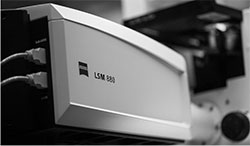John A. Payne, Ph.D.

Professor Emeritus
japayne@ucdavis.edu
Primary Research Focus
The primary interest of the Payne Lab is to understand how excitable cells maintain intracellular ion and water homeostasis. We are particularly interested in the regulation of intracellular [Cl-] of neurons and cardiomyocytes.
Research Interests
My laboratory examines the cellular physiology of the cation chloride cotransport proteins, including the Na-K-Cl cotransporter (NKCC) and K-Cl cotransporter (KCC). We are particularly interested in the function of these transport proteins in excitable cells, i.e, neurons and muscle cells. We have identified an isoform of the K-Cl cotransporter (KCC2) that is important in maintaining low intracellular [Cl-] for the proper function of ligand-gated anion channels (GABAA and glycine receptors) in postsynaptic inhibition of mature neurons. The regulation of the cation chloride cotransporters is an important area of our research. Both NKCC and KCC2 appear to have significant roles in regulating intracellular [Cl-] and cell volume of neurons. How are changes in these cell parameters linked to alteration in the activity of the cotransporters? In the life of a neuron intracellular [Cl-] undergoes dynamic changes, such as during neuronal development or following traumatic insults. These changes in intracellular [Cl-] will lead to alterations in GABAAergic transmission. Are changes NKCC and KCC2 transport activity linked to these events and if so how? We are studying the regulation of NKCC and KCC2 by examining changes in both their kinetic activity and surface protein expression. In addition to their function at the cell level, I am interested in the structure of these proteins and how they function at the molecular level. How do the cotransporters interact with the ions they transport and the inhibitors they bind? Where are these sites of interaction within the protein? How do the cotransporters interact with other regulatory proteins? My laboratory uses whole animal, cellular, and molecular experimentation to answer many of these questions.
Graduate Group Affiliations
An updated list of current publications: Google Scholar
Karlócai, M.R., L. Wittner, K. Tóth, Z. Magloczky, Z. Katarova, G. Botond, G. Rásonyi, L. Erőss, S. Czirják, P. Halász, G. Szabó, J.A. Payne, K. Kaila, T.F. Freund. “Enhanced expression of potassium-chloride cotransporter KCC2 in human temporal lobe epilepsy”. Brain Struct. Funct. 221: 3601-3615, 2016.
Voipio, J., W.F. Boron, S.W. Jones, U. Hopfer, J.A. Payne, and K. Kaila. “Comment on "Local impermeant anions establish the neuronal chloride concentration"”. Science 345: 1130, 2014.
Kaila, K., T.J. Price, J.A. Payne, M. Puskarjov, and J. Voipio. “Cation-chloride cotransporters in neuronal development, plasticity, and disease”. Nature Rev. Neurosci., 15: 637-654, 2014.
Sharp, J.W., C.M. Ross-Inta, I. Baccelli, J.A. Payne, J.B. Rudell, and D.W. Gietzen. “Effects of essential amino acid deficiency: downregulation of KCC2 and the GABAA receptor and disinhibition in the anterior piriform cortex”. J. Neurochem. 127: 520-530, 2013.
Payne, J.A. “Molecular operation of the cation chloride cotransporters: ion binding and inhibitor interaction”. Curr. Topics Membr. 70: 215-237, 2012.
Antrobus, S.P., C. Lytle, and J.A. Payne. “K+-Cl- cotransporter-2 (KCC2) in chicken cardiomyocytes”. Am. J. Physiol. Cell Physiol. 303: C1180-C1191, 2012.
Payne, J.A., The potassium-chloride cotransporters: from cloning to structure and function. In Physiology and Pathology of Chloride Transporters and Channels in the Nervous System: From Molecules to Diseases. (Ed. F.J. Alvarez-Leefmans and E. Delpire). Elsevier, 2009. pp. 333-356.
Chung, C.-Y. and J.A. Payne. Rapid degeneration of the neuronal K-Cl cotransporter, KCC2, after trauma. In Encyclopedia of Basic Epilepsy Research, (Ed. P.A. Schwartzkroin). Elsevier, 2009. pp. 1410-1415.
Lee, H.H.C., J.A. Walker, J.R. Williams, R.J. Goodier, J.A. Payne, and S.J. Moss. “Direct PKC-dependent phosphorylation regulates the cell surface stability, endocytosis, and activity of the potassium chloride cotransporter, KCC2”. J. Biol. Chem., 282(41): 29777-29784, 2007.
Williams, J.R. and J.A. Payne. “Cation transport by the neuronal K-Cl cotransporter, KCC2: Thermodynamics and kinetics of alternate transport modes”. Am. J. Physiol. Cell Physiol. 287: C919-C931, 2004.
Rivera, C., J. Voipio, J. Thomas-Crusells, H. Li, Z. Emri, S. Sipila, J.A. Payne, L. Minichiello, M. Saarma, and K. Kaila. “Mechanism of activity-dependent downregulation of the neuron-specific K-Cl cotransporter, KCC2”. J. Neurosci. 24: 4683-4691, 2004.
Payne, J.A., C. Rivera, J. Voipio, and K. Kaila. “Cation chloride cotransporters and their role in neuronal communication, development, and trauma”. Trends in Neurosci., 26(4): 199-206, 2003.
Gulyas, A.I., A. Sik, J.A. Payne, K. Kaila, and T.F. Freund. “The K-Cl cotransporter, KCC2, is highly expressed in the vicinity of excitatory synapses in the rat hippocampus”. Eur. J. Neurosci. 13: 2205-2217, 2001.
Payne, J.A., C. Ferrell, and C.-Y. Chung. “Endogenous and exogenous Na-K-Cl cotransporter expression in a low K+-resistant mutant MDCK cell line”. Am. J. Physiol. Cell Physiol. 280: C1607-C1615, 2001.
Williams, J.R., J.W. Sharp, V.G. Kumari, M. Wilson, and J.A. Payne. “The neuron-specific K-Cl cotransporter, KCC2: antibody development and initial characterization of the protein”. J. Biol. Chem. 274(18): 12656-12664, 1999.
Rivera, C., J. Voipio, J.A. Payne, E. Ruusuvuori, H. Lahtinen, K. Lamsa, U. Pirvola, M. Saarma, K. Kaila. “The K+/Cl- co-transporter KCC2 renders GABA hyperpolarizing during neuronal maturation”. Nature 397: 251-255, 1999.
Payne, J.A. “Functional characterization of the neuronal-specific K-Cl cotransporter: implications for [K+]o regulation”. Am. J. Physiol. Cell Physiol. 273: C1516-C1525, 1997.
Payne, J.A., T.J. Stevenson, and L. Donaldson. “Molecular characterization of a putative K-Cl cotransporter in rat brain a neuronal-specific isoform”. J. Biol. Chem 271 (27) 16245-16252, 1996.
Gillen, C.M., S. Brill, J.A. Payne, and B. Forbush III. “Molecular cloning and functional expression of the K-Cl cotransporter from rabbit, rat, and human: a new member of the cation-chloride cotransporter family”. J. Biol. Chem. 271 (27): 16237-16244, 1996.
- HPH/NPB 157, Advanced Physiology of Animal/Human Disease, Instructor of Record
- HPH400, Human Physiology
- HPH493C, Special Studies Module




 Make a donation using our secure online system.
Make a donation using our secure online system.